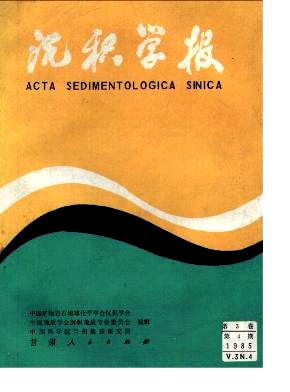ALLOCHTHONOUS CARBONATE SEDIMENTS ALONG THE PLATFORM-FORESLOPE FROM THE QIZIQIAO FORMATION ( MIDDLE DEVONIAN ) OF DAOXIAN AND NINGYUAN COUNTIES, HUNAN PROVINSE
- Received Date: 1984-01-21
- Publish Date: 1985-12-10
Abstract: Ancient resedimented carbonates along platform-foreslope are considered as a deep-water type of carbonates, including gravity flows, gravity slide ( slump ) deposits, and talus wedges ( aprons ) . A series of deposits belonging to this kind of carbonates found from the intraplatform basin developed in Middle Devonian Qiziqiao Formation,north of Daoxing and east of Ningyuan, Hunan.They are around or adjacent to the restricted platform ( RC ) or open platform ( P ) (Fig.1 ) .The following four kinds of allochthonous carbonate sediments basically belonging to foreslope can be recongnized:( 1 )the slump psephitic limestone of fore-platform(Platel-l); (2)the allochthonous calcarenite Plate 1-2,3 ,Fig. 2 ); ( 3 ) the allochthonous calcisiltite ( Plate 2 -2 , 3 ); and ( 4 ) the talus limestone of reef-scarp (Plat 2-1 , Fig. 3 ) . These types of sedimentary rocks represent a transitional series which can be respectively regarded by the author as the product of gravity slide, secondary grain flows, foreset bed of turbidity flows (Fig. 2, below ) and talus reef-scarp aprons. Several different types of deposits, such as gravity slide and gravity flow, can be found on the same vertically geological section. The debris slides may synchronously bring about extensive debris flows, secon-dary grain flows and turbidity flows.According to their occurrence, petrological cha- racters, single bed thickness, inversely graded bedding,and massive non-graded unit, etc., it seems that the calcarenites of the study area may be compared with the modern secondary grain flows at the base of Bahama Escarpment 400m below reported by H.T.Mullins, and to have a similar sequence to allochthnous turbidity limestone ( Eder, 1970) .However, compared with mass calcarenites newly interpreted by I.M. Hurst,et al. ( 1983 ) ,the most likely mechanism for deposition of the calcarenites is the transition from high-density turbidity flows to liquefied flows.The gravity flows were quite developed from the last Middle to early Upper Devonian in South China. In addition to gravity flows and gravity slides of that age,synsedimentary faults at sea floor, a series of crinkled bedding of contemporaneous deformation, as well as submarine fans in northern Guangdong Province next to this area, and submarine erupted basalts in Guangxi Province are all the best evidences for the powerfully submarine tectonic movements. The gravitation on foreslope. especially the associated paleoearthquake, is probably the major factor of the mass movement of sediments at the sea-floor.
| Citation: | Yang Zhenqiang. ALLOCHTHONOUS CARBONATE SEDIMENTS ALONG THE PLATFORM-FORESLOPE FROM THE QIZIQIAO FORMATION ( MIDDLE DEVONIAN ) OF DAOXIAN AND NINGYUAN COUNTIES, HUNAN PROVINSE[J]. Acta Sedimentologica Sinica, 1985, 3(4): 55-62. |






 DownLoad:
DownLoad: